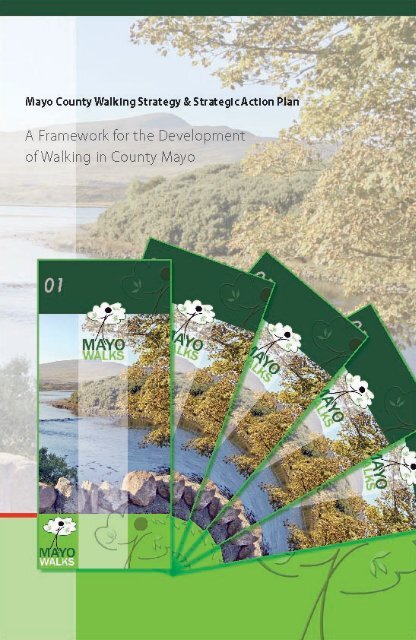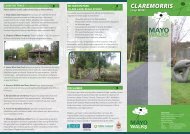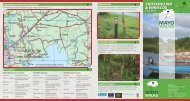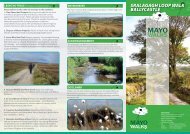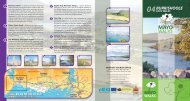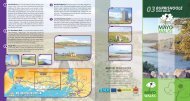Walking Strategy Document (PDF; 3.7 MB) - Mayo Walks
Walking Strategy Document (PDF; 3.7 MB) - Mayo Walks
Walking Strategy Document (PDF; 3.7 MB) - Mayo Walks
Create successful ePaper yourself
Turn your PDF publications into a flip-book with our unique Google optimized e-Paper software.
MAYOWALKSConnaught Telegraph Printers, CastlebarPhoto courtesy of David Moran, Newportp<strong>Mayo</strong> Count y <strong>Walking</strong> <strong>Strategy</strong> & Strategic Ac tion Plan
Table of ContentsExecutive Summary2IntroductionBackgroundCall For Submissions33Policy Context4Benefits Of <strong>Walking</strong>EconomicHealthSocial, Environmental & Leisure455<strong>Mayo</strong>’s Advantages6PartnersLocal SupportsNational Supports66Challenges/issuesChallengeIssues78<strong>Strategy</strong> & Action PlanI Trail DevelopmentII Product Development & PromotionIII Trail Maintenance101215References16AppendicesAppendix AAppendix BAppendix CAppendix DAppendix E1718192021April 2007<strong>Mayo</strong> Count y <strong>Walking</strong> <strong>Strategy</strong> & Strategic Ac tion Planp
IntroductionBackgroundFollowing the adoption of a proposal by the Cultural, Education, Heritage and CorporateAffairs Strategic Policy Committee of <strong>Mayo</strong> County Council, it was resolved by the Councilto eatablish a <strong>Walking</strong> Partnership (Appendix A) to “establish <strong>Mayo</strong> as the walking capitalof Ireland”. The <strong>Walking</strong> Partnership was setup by the County Development Board (CDB)in November 2005. A ten person Working Group (Appendix B) of the <strong>Walking</strong> Partnershipwas also set up, with representation from Leader Companies, the HSE, Meitheal Mhaigheo,<strong>Mayo</strong> Sports Partnership, Civil Defence, County Community Forum, Ireland West Tourism,Teagasc, and the VEC. Foremost amongst the objectives of the <strong>Walking</strong> Partnership andWorking Group was the development and publishing of a County <strong>Walking</strong> <strong>Strategy</strong>and Action Plan to co-ordinate and drive the sustainable development and promotionof walking in the county. This document represents the first formal steps towardsimplementation of the objective.Call for SubmissionsFollowing the establishment of the County <strong>Walking</strong> Partnership and Working Group,submissions were sought from the public as to the issues and challenges that the WorkingGroup needed to address. Public notices were placed in local press in December 2005and 22 submissions were received both from individuals and organisations. All issuesraised are listed in Appendix C and are addressed throughout this strategy document. Acomplete list of individuals and organisations that responded to the call for submissionsis also included in Appendix D.<strong>Mayo</strong> Count y <strong>Walking</strong> <strong>Strategy</strong> & Strategic Ac tion Planp
Policy ContextThe Cultural, Education, Heritage and Corporate Affairs Strategic Policy Committee of <strong>Mayo</strong> CountyCouncil recommended the establishment of a County <strong>Walking</strong> Partnership following a visit bymembers and officials of <strong>Mayo</strong> County Council to the Lake District in England August 2005. Foremostamongst the objectives of this <strong>Walking</strong> Partnership, established under the County DevelopmentBoard, was the development and publishing of a County <strong>Walking</strong> <strong>Strategy</strong> and Action Plan to coordinateand drive the sustainable development and promotion of walking in the county.The drafting of a County <strong>Walking</strong> <strong>Strategy</strong> and Action Plan for County <strong>Mayo</strong> comes in the context ofmany national developments in countryside recreation and walking such as the publication of botha National Countryside Recreation <strong>Strategy</strong> , and an Irish Trails <strong>Strategy</strong> . It also comes on the backof calls, regionally, for the development of walking at a local level, specifically so in the ‘<strong>Walking</strong> inthe West…a Step-by Step Guide’ document produced last year. Having already developed a Local<strong>Walking</strong> Partnership (LWP), as that document advocates, this strategy and action plan is an attemptto lay a framework for the development and promotion of walking in the county. Locally, <strong>Mayo</strong>Sports Partnership is committed to “increasing the levels of sports participation in <strong>Mayo</strong>” (pp. 21) andwalking is seen as a means to achieving this objective. Amongst MSP strategic actions for 2006/07is to “produce a walking strategy and facilitate communities in the development of walking at a locallevel” (pp. 5).Benefits of <strong>Walking</strong>The benefits of walking, and its development within the county, are manifold. They arediscussed below under the three broad headings of economic benefits, health benefits, andsocial, environmental and leisure benefits. Benefits include; benefits to individuals, benefits tothe county and benefits to communities.EconomicThere are significant economic incentives to encourage the development of walking in County<strong>Mayo</strong>. The development of walking trails in the county has the potential to generate revenuethrough both domestic trail use and through overseas walking tourism. A recent studycommissioned jointly by the Irish Sports Council (ISC) and Coillte revealed the true extent of theeconomic value of trails and forest recreation . This comprehensive piece of research estimatedthe total direct economic impact of trail usage by Irish residents alone at €307 million annuallyand takes into account both expenditure on walking equipment and expenditure by trail userson food, drink, accommodation etc.Meanwhile, according to Fáilte Ireland statistics , over 250,000 overseas visitors participated inhiking or hillwalking while in Ireland, spending an estimated €170 million in 2004. The samestatistics reveal that 45% of these visitors visited the Western region of Ireland and that 88%of those that went hiking and/or hillwalking regarded the opportunity to take part in theseactivities as important in their decision to come to Ireland for a holiday.1Comhairle Na Tuaithe. National Countryside Recreation <strong>Strategy</strong> 20062Irish Trails <strong>Strategy</strong>, Irish Sports Council 20063<strong>Walking</strong> in the West… a Step-by Step Guide 2005 – Western Development Commission / Tourism Programme / Leader Programme4<strong>Mayo</strong> Sports Partnership Strategic Plan 2006-20095<strong>Mayo</strong> Sports Partnership Implementation Plan 2006-20076The Economic Value of Trails & Forest Recreation in Ireland, Fitzpatrick Associates 20057Fáilte Ireland. Hiking/Hillwalking 2004p<strong>Mayo</strong> Count y <strong>Walking</strong> <strong>Strategy</strong> & Strategic Ac tion Plan
The development of new walking trails and the upgrade of existing trails in <strong>Mayo</strong>, accompaniedby an appropriate promotion and marketing strategy, will result in <strong>Mayo</strong> increasing its marketshare of walking tourism in Ireland. Moves afoot nationally, such as Comhairle na Thuaithe’sNational Countryside Recreation <strong>Strategy</strong>, the impending Irish Sport Council’s Irish Trails<strong>Strategy</strong> and a renewed impetus behind the promotion of Ireland as a walking destination byFáilte Ireland offer the prospect of increased walking tourism countrywide. The developmentand marketing of <strong>Mayo</strong>’s walking product should see it take a sizeable portion of this increasingnational market. Coming, as it does, in a climate of dramatic change in the farming sector andthe ‘clear tendency for increasing numbers of farm families to choose to combine running a farmingenterprise with other occupations’ (pp. 22), the exploitation of <strong>Mayo</strong>’s potential as a walkingdestination is critical in assuring a thriving tourism market with the associated seasonal spin-offindustry that this would create.HealthThe development and promotion of walking in <strong>Mayo</strong> will have the potential to significantlybenefit the health and wellbeing of local communities through the encouragement of physicalactivity. The National Health and Lifestyle Surveys (SLAN) reveal that the number of individualsmeeting their recommended weekly physical activity levels has fallen between 1998 and2002 10 . The national health promotion strategy identifies that environmental conditions canact to promote our health and well being through the provision of recreational facilities. Theprovision of safe and accessible walking trails, accompanied with the effective promotion ofwalking as an inexpensive form of physical activity, should therefore go some way to reversingthe trend towards a sedentary lifestyle and towards encouraging active living. The Irish HeartFoundation’s Slí na Sláinte routes have already proved successful in this regard.Social, Environmental & Leisure‘Recreational trails provide a broad range of environmental, cultural and social benefits, whichcollectively result in a higher quality of life, a healthier environment and more attractive communitiesfor people’ 11 . They provide a means of social interaction and may prevent feelings of isolation,which may occur particularly in rural areas and amongst the elderly. <strong>Walking</strong> trails may thereforehave a function in renewing traditional community values.There are also significant environmental benefits to be gained from the development of walkingtrails in County <strong>Mayo</strong>. Encouraging people in the county to take up walking as a healthy lifestylewill result in many abandoning use of cars for short trips to work, school, etc. This would havesignificant benefits to the environment in terms of reducing pollution caused by driving as wellas the health benefits associated with an active lifestyle. The development of walking trails mayalso encourage a respect for nature and an interest in the heritage and history of the area.<strong>Walking</strong> is an accessible form of outdoor recreation, which requires the purchase of minimalequipment, compared to other outdoor recreational pursuits. The development of walkingtrails will ensure that this accessible activity becomes available countywide, and will afford allinterested individuals the opportunity to partake in this low-cost leisure activity.8Fáilte Ireland. Strategic Development Plans for Ireland’s <strong>Walking</strong> Tourism Product 2003-20069Report of the Agri Vision 2015 Committee 2004.10Results of National Health and Lifestyle Surveys SLÁN 200211Irish Trails <strong>Strategy</strong>, Irish Sports Council 2006<strong>Mayo</strong> Count y <strong>Walking</strong> <strong>Strategy</strong> & Strategic Ac tion Planp
<strong>Mayo</strong>’s Advantages<strong>Mayo</strong>’s largely unspoilt, clean countryside, varying landscapes, unique scenery and rich heritageand folklore mark it as an ideal walking destination. It can offer most types of walks includingmountain and hill walks, coastal and island walks, and rural and urban walks. The variety ofwalks on offer may combine to offer an unrivalled and unforgettable experience for walkingtourists. The implementation of this strategy and action plan will drive the development of<strong>Mayo</strong> as a walking destination and may ultimately lead to it realising the obvious potential thatit possesses.PartnersLocal Supports• <strong>Mayo</strong> County Council• <strong>Mayo</strong> County Development Board• <strong>Mayo</strong> <strong>Walking</strong> Partnership & Working Group• Ireland West Tourism• Údarás na Gaeltachta & Gael Saoire• <strong>Mayo</strong> Sports Partnership• Leader Partnership Companies• Community Groups• Dept. of Community, Rural and Gaeltacht Affairs.National Supports• Irish Sports Council/National Waymarked Ways Programme• Comhairle Na Tuaithe• Fáilte Ireland• Western Development Tourism Programme• Coillte• National Parks & Wildlife Service• Dept. Community Rural & Gaeltacht Affairsp<strong>Mayo</strong> Count y <strong>Walking</strong> <strong>Strategy</strong> & Strategic Ac tion Plan
Challenges/IssuesThere will undoubtedly be many challenges and issues to be overcome in the drive to establish<strong>Mayo</strong> as the walking capital of Ireland. Although it would be impossible to predict everychallenge, it seems prudent that some of the more obvious ones be discussed presently, in orderthat they do not act as “stumbling blocks” should they arise. The following nine challenges andissues have been identified for discussion:ChallengesIssuesaudit of <strong>Walks</strong>Development of Key <strong>Walks</strong>Co-OrdinationPromotion and MarketingManagement & MaintenanceCompetitionParticipation of CommunitiesaccessinsuranceSafetyBuy inChallengesAudit of <strong>Walks</strong>In order to “take stock” of the current status in relation to walking routes in the county, <strong>Mayo</strong>Coumnty Development Board has engaged with local communities in completing an audit ofwalks. A number of submissions have been received documenting both existing walks andsites with potential for the development of walks. At this stage each of these walks have beenmarked on a map of the county allowing easy identification of regions abundant in walks and,importantly, those areas requiring walking development. It is envisaged that the completedaudit of walks be repeated and updated as new walks are developed. It will serve as a usefulresource and as a database of walks in the county (Appendix E)Development of Key <strong>Walks</strong> – Mix of Geography and TerrainThe development of walks which traverse a variety of landscapes, including ; bog land,mountainous regions, coastal plains etc. represents a significant challenge to the developmentof walking in the county. Varying types of terrain present different challenges. For exampledrainage may be an issue on walks crossing bog lands, whereas erosion may be the main concernin upland areas. Issues such as these will be addressed as they arise during walks developmentand ongoing maintenance by the CDB <strong>Walking</strong> Partnership.Co-ordinationThe task of coordinating the development, packaging, marketing and promotion of walking inthe county will represent a sizeable challenge for <strong>Mayo</strong> CBD. Therefore it is one of the principlerecommendations of this <strong>Strategy</strong> and Action Plan that a suitable candidate be employed ascounty walking development officer on a full-time basis, as recommended by the Cultural,Education, Heritage and Corporate Affairs Strategic Policy Committee of <strong>Mayo</strong> County Council.It would be his/her role to co-ordinate and oversee all developments in relation to walking in thecounty and the successful candidate would be employed within the Community and EnterpriseSection and would report to The Director of Community and Enterprise. The walking officerwould work in liaison and in co-operation with all agencies and communities involved in thedevelopment of walking in the county.<strong>Mayo</strong> Count y <strong>Walking</strong> <strong>Strategy</strong> & Strategic Ac tion Planp
Although the access issue remains unresolved nationally, it should not effect trail developmentlocally in <strong>Mayo</strong>, which may proceed cautiously with appropriate consultation of landowners overplanned developments.InsuranceAt present, the owners and occupiers of private property crossed by an approved nationalwaymarked way must be indemnified against any negligence claims by a recreational walker foraccident, damage or injury sustained while walking on private property. This indemnity is primarilyprovided through a policy administered by Irish Public Bodies Mutual Insurance Ltd. The validityof the liability insurance through IPBMI is dependant on NWWAC/ISC being able to confirm thatthe route is safe. As such all national waymarked ways are inspected annually and the responsibleauthority/local management committees are expected to have a maintenance programme inplace for the walking route to ensure the route is maintained. The owner / occupier of any privateproperty is further protected in Irish law under the provisions of the Occupiers Liability Act 1995.Under the Act, the duty of care to a recreational user is the same as to a trespasser. The owner oroccupier is required to refrain from intentionally injuring persons or damaging their property, oracting “with reckless disregard” for their safety.Most recreational trail developments in Ireland have depended on the permission and goodwillof both public and private landowners to develop walking routes on, or through their property.A permissive way is not a public right of way but a route that can be used by the public withthe permission of the landowner. The responsible authority or management committee normallyestablishes public liability insurance where all landowners/occupiers are indemnified againstinjury resulting from use of the walking route and a landowner may withdraw this permissionwith reasonable notice.SafetyIssues of walkers’ safety are of paramount concern. The development of off-road walks is thereforepreferable to on-road walks which have the added safety concern of traffic. Off-road walks arenot however without their safety concerns and education programmes for walkers engagingin these walks are essential. Simple walking safety leaflets such as that produced jointly by theIrish Sports Council (ISC) and the Mountaineering Council of Ireland (MCI) 13 could go along waytowards informing walkers of the various necessary precautions and planning procedures prior toundertaking a walk.13Walk Safely leaflet available to download at: http://www.mountaineering.ie/mci/safety/Walkers_Safety.final.pdf<strong>Mayo</strong> Count y <strong>Walking</strong> <strong>Strategy</strong> & Strategic Ac tion Planp11
<strong>Strategy</strong> & Action PlanThe strategy and action plan for the development of walking in County <strong>Mayo</strong> has been dividedhere into three strategic strands;I. Trail DevelopmentII. Product Development & PromotionIII. Trail MaintenanceA series of planned actions under each strategic strand are outlined in this document. Wherepossible, an agency or agencies responsible for delivery on each action is identified. Much ofthe work involved in all three strands will require central co-ordination by the <strong>Mayo</strong> CountyDevelopment Board <strong>Walking</strong> Partnership. It is therefore recommended that, in line withmoves in other counties such as Cork-Kerry, Wicklow and Donegal, a suitable candidate beemployed as county walking development officer on a full-time basis, reporting to the Directorof Community and Enterprise <strong>Mayo</strong> Local Sports Partnership recommends the appointmentof sports development officers in their implementation plan 2006-07. While walking is notnecessarily a sport, as a recreational activity it has the potential to increase physical activitylevels in the community and <strong>Mayo</strong> Local Sports Partnership would be supportive of moves tointroduce a county walking officer. The role of the person appointed will be to co-ordinate thedelivery of the actions outlined in this strategy.ITrail DevelopmentThe Trail Development Strand focuses on both the upgrading of existing walking trails and theprovision of new walking trails. The upgrading of existing linear walks, the development of newlinear walks and the development of localised loop walks are the three key elements of thisstrategy and are discussed presently.Upgrading of Existing Linear <strong>Walks</strong><strong>Mayo</strong>’s three established linear walks, the Western Way, the Bangor Way, and the Foxford Wayremain of foremost importance in spearheading the drive to establish <strong>Mayo</strong> as the walkingcapital of Ireland. It is thus of critical importance that these three trails are developed andmaintained to recognised best practice standards. The upgrading of these three trails, currentlyin varying levels of disrepair, is therefore a major priority for the development of walking inthe county. The <strong>Mayo</strong> County Development Board will take responsibility for co-ordinatingthe upgrading work required on these three walking trails. The nature of the upgrade workwill include the provision, where required, or the repair, of existing mapboards, waymarkers,directional arrows, gates, stiles, and footbridges. Issues of erosion and drainage will also beaddressed. It is acknowledged that some of the work has been completed or is in the processof being completed by the Rural Social Schemes operating within Leader Companies in theCounty.Development of New Linear <strong>Walks</strong>Key to the establishment of <strong>Mayo</strong> as the walking capital of Ireland is the further developmentof new linear walks. In particular, <strong>Mayo</strong> County Development Board is committed to thedevelopment of the Tóchar Valley Way and the Achill Spur linear walk, which links off the Westernand Bangor Ways. <strong>Mayo</strong> County Development Board has already committed €20,000 to thedevelopment of phase 1 of the Achill Spur linear walk (to Mulranny) which is now complete.p12<strong>Mayo</strong> Count y <strong>Walking</strong> <strong>Strategy</strong> & Strategic Ac tion Plan
Development of Localised LoopsIn recognition of current walking trends, <strong>Mayo</strong> County Development Board is committed to thedevelopment of walking routes catering for the needs of experienced and “occasional walkers” 14 .In this regard, the development of localised loop walks of 1.5hrs to 4.5hrs in duration is a priority.<strong>Mayo</strong> County Development Board will assist community groups and other agencies involved inthe development of localised loop walks, whether they be linked to the five existing linear walksor “stand alone walks”. A formal structure covering the extent and nature of such assistance willbe developed. Groups involved in the development of localised loop walks will be expected todevelop those walks in line with the criteria laid out by Fáilte Ireland. Two local loops, the ClogherBog Loop and the Lettermaghera Loop have already received funding through phase one of theFáilte Ireland Looped Walk Initiative. It is also proposed that, under phase two of this initiative,funding will be allocated towards the development of Achill Head Loops, Doonagh Loop, DeerparkLoop, Aghagower and Carrafull Loop. The Fáilte Ireland Looped Walk Initiative represents anexcellent opportunity to acquire necessary funding to put towards the development of loopwalks. Should there be further phases of the Fáilte Ireland initiative <strong>Mayo</strong> County DevelopmentBoard will support and lobby for the inclusion of further walks in <strong>Mayo</strong> in the scheme.Actions Arising from The TrailDevelopment StrandResponsible Agenciesi. Upgrade <strong>Mayo</strong>’s three linear walks <strong>Mayo</strong> County Council, County Development Board· Western Way <strong>Walking</strong> Partnership Working Group,· Bangor Way national Parks & Wildlife Service,· Foxford Way leader Partnership Companiesii.iii.Develop New Linear <strong>Walks</strong>· Achill Spur <strong>Mayo</strong> County Council, County Development· Tóchar Valley Way Board <strong>Walking</strong> Partnership Working Group,Community Groups, Leader Partnership CompaniesDevelop Localised LoopsEither:Community Groups, Leader Partnership· Off the five linear walks Companies, <strong>Mayo</strong> County Council, CountyAnd/Or:Development Board <strong>Walking</strong> Partnership· “Stand alone walks” Working Group, Fáilte IrelandImplementation.In order to implement the Trail Development Strand the following actions are proposed;1. Appoint full time <strong>Walking</strong> Development Officer.2. Prepare a 3 year implementation plan 2007 – 2009 that identifies the work to be deliveredeach year including the cost of projects, the potential funding sources andthe partnerships required.3. Establish an Inter-agency Implementation Team under the County Development Board todeliver the various projects in association with the County <strong>Walking</strong> Officer.14The Occasional Walker; walks for more than 2hrs on average less than twice a month; has limited though variable fitness levels; haslimited navigation or emergency procedures skills; has limited knowledge of access issues and is unlikely to have done any researchon the walk prior to arrival – Definition from Fáilte Ireland’s Criteria for the Development of Loop <strong>Walks</strong> 2006.<strong>Mayo</strong> Count y <strong>Walking</strong> <strong>Strategy</strong> & Strategic Ac tion Planp13
IIProduct Development & PromotionThe product development and promotion strand focuses on the delivery of a world classwalking product. Quite distinct from the Trail Development Strand, this section is concernedwith the delivery of the additional services, information, structures and marketing requiredto compliment the provision of the physical walking trail. Guidebooks, marketing andpromotion, the categorisation of walks, the standardisation of trail furniture 15 , and educationand training are key elements of developing the walking product.GuidebooksKey to the development of a marketable walking product for County <strong>Mayo</strong> is the developmentand publication of quality guidebooks for the established walks in the county. Guidebookswill include accurate maps of the route as well as information on the heritage, history andflora and fauna that walkers encounter along the walk. Such guidebooks will increase boththe enjoyment and the quality of the walking experience on offer. Guidebooks, while actingprimarily as a guide to a particular walk, will also serve some purpose as a promotional tool.Marketing & PromotionFor <strong>Mayo</strong> to become the walking capital of Ireland, the redevelopment of its walking trails mustbe accompanied by a marketing and promotion plan, aimed at attracting both domestic andforeign tourists. The publishing and dissemination of promotional brochures and leaflets ispivotal in this regard. The design and publishing of a series of standard county-wide walkingleaflets, featuring all developed walks in the county is regarded as a priority area.Developed walks should also feature prominently on existing websites involved both withthe promotion of Irish walking tourism and Irish tourism generally. Some such websitesinclude; www.ireland.ie, www.walkireland.ie, www.walking.ireland.ie. It will be necessaryto liaise with the operators of these websites to ensure that each developed walk in thecounty is featured, particularly as new walks are developed. This strategy also proposesthe development of a <strong>Mayo</strong> <strong>Walks</strong> website and towards this objective the domain www.mayowalks.ie has been reserved.Since the Internet offers a relatively inexpensive means of advertising the county as a walkingdestination to an international audience, the design and launch of a specific purpose website,promoting walking in <strong>Mayo</strong>, is advocated. The Site would be developed by the <strong>Walking</strong>officer in association with Failte Ireland / Ireland West., the Leader Partnership companiesand other relevant bodies on the <strong>Walking</strong> Partnership..The marketing and promotion strategy will also endeavour to portray the development ofwalking in <strong>Mayo</strong> as a resource to the local community. Locals will be encouraged take upwalking in the county, as they are the most likely “year-round users”. Publicity around theobjective of making <strong>Mayo</strong> Ireland’s walking capital will offer an ideal opportunity to promotewalking as a healthy activity for all. Health promotion agencies will be encouraged to usethe opportunity to run health promotion programmes emphasising the benefits of walkingas an accessible and inexpensive form of exercise.Categorise <strong>Walks</strong>In order that walking in the county be packaged and promoted effectively as a product eachdeveloped walk will be categorised, not only according to it’s level of difficulty, but also withrespect to the nature of the walk and it’s accessibility. <strong>Walks</strong> may primarily be categorisedp14<strong>Mayo</strong> Count y <strong>Walking</strong> <strong>Strategy</strong> & Strategic Ac tion Plan
according to the predominant theme or feature of the walk. For example, a walk might bedescribed as a Heritage; Nature; Mountain; Lake, Coastal, or Island walk.A level of difficulty rating will also be assigned to each walk. This role is carried out nationallyby the Irish Sports Council which is charged with the annual inspection of Ireland’s NationalWaymarked Ways. In order that newly developed walks in County <strong>Mayo</strong> be accepted into thenational network of Irish Waymarked Ways, they will have to satisfy criteria set down by ISCand undergo inspection by Irish Sports Council accredited inspectors. Subject to favourableoutcomes of such inspections, our trails will become part of the national network and willenjoy the benefits of annual inspections. They will also be graded based on their level ofdifficulty by the Irish Sports Council. It will take time for each developed trail in the countyto be accepted into the national network and, in the interim, trails will be graded for difficultywith guidance from local expertise. The <strong>Walking</strong> Partnership will set objectives ands targets forthe acceptance of trails nationally and these will be monitored by the <strong>Walking</strong> Officer.Finally, walks will be graded in terms of their accessibility for different users. Potential walkersmust be made aware if walks are unsuitable for use by families or wheelchair users, etc. Thisinformation will be included in guidebooks, promotional brochures and leaflets as well as onrelevant websites.Standardised Trail FurnitureStandardised mapboards, waymarkers, directional arrows, gates, stiles footbridges andother trail furniture will be provided on all walking routes in the county. A standardised anduniform set of trail furniture will be agreed by the <strong>Walking</strong> Partnership and promoted by the<strong>Walking</strong> Officer. This will portray an integrated and professionally developed walking product.In agreeing standards, due recognition will be given to national standards and existing trailfurniture in the County.Training & EducationThe training of walking guides is regarded as important to the development and continuedgrowth of walking in the county. <strong>Mayo</strong> County Development Board recognises, and is gratefulfor, the ongoing work of the Galway−<strong>Mayo</strong> Institute of Technology and <strong>Mayo</strong> VEC in thisregard. Galway−<strong>Mayo</strong> Institute of Technology offers an outdoor education course whichqualifies many students in Castlebar to Mountaineering Council of Ireland standards to leadgroups in hill and mountain walking. <strong>Mayo</strong> VEC offers the Fáilte Ireland approved Marine andCountryside Management Certificate.The challenge is to ensure that all qualified guides, who are interested in doing so, are activelyengaged in guiding walks. A programme of dialogue between GMIT, VEC and the <strong>Walking</strong>Partnership Working Group will be initiated as part of this strategy.Further to the training of walking guides for tourists, it is essential that local volunteers receivetraining and education to become qualified as walking leaders within the community. <strong>Mayo</strong>Sports Partnership has been active in this regard, particularly so through the “<strong>Mayo</strong> in Motion”initiative they ran last year. The participation of locals is essential to ensure a sustainableand year-round trail usage. The <strong>Mayo</strong> CDB <strong>Walking</strong> Partnership is committed to the ongoingtraining and education of both guides for tourists and walking leaders within the localcommunity. The walking partnership through the walking officer will agree targets with thetraining agencies in relation to training.<strong>Mayo</strong> Count y <strong>Walking</strong> <strong>Strategy</strong> & Strategic Ac tion Planp15
Actions Arising from The Product Development& Promotion StrandResponsible Agenciesi. Guidebooks<strong>Mayo</strong> County Development Board <strong>Walking</strong>Partnership Working Group,Leader Partnership Companiesii.Marketing & Promotion· Brochures & Leaflets· Internet· Local Health Promotion· Design of Specific purpose websiteIreland West Tourism, Fáilte Ireland,www.ireland.ie,www.walkireland.ie,www.walking.ireland.ieHealth Promotion Agencies<strong>Mayo</strong> County Development Board <strong>Walking</strong>Partnership Working Group, LeaderPartnership Companieswww.mayowalks.ieiii.Classification· Nature of walk· Difficulty of walk· Accessibility of walkLocal walking enthusiasts,ISC Trail Inspectorsiv.Signage/Furniture<strong>Mayo</strong> County Development Board <strong>Walking</strong>Partnership Working Group,<strong>Mayo</strong> County Council,Fáilte Ireland, Leader Companies,Leader Partnership Companiesv. Education & Training· Train walking guides to MCI standards· Ensure trained guides are active· Provide Training/Education for<strong>Walking</strong> Leaders in the CommunityGMIT Castlebar, VEC,<strong>Mayo</strong> County Development Board <strong>Walking</strong>Partnership Working Group,<strong>Mayo</strong> Local Sports Partnership,Leader Partnership Companiesp16<strong>Mayo</strong> Count y <strong>Walking</strong> <strong>Strategy</strong> & Strategic Ac tion Plan
IIITrail MaintenanceTrail InspectionThe Irish Sports Council is charged with the annual inspection of Irelands’ National WaymarkedWays. It will be the objective of the strategy to have all developed walks in the countyrecognised as part of the national network of Waymarked Ways, where they will enjoy thebenefit of annual inspection by the Irish Sports Council. It will take some time to reach thisstage and, in the interim, the onus will be on local community groups, in conjunction withthe <strong>Mayo</strong> County Council and Leader Partnership Companies, to carry out inspections and toensure that walks are maintained to a reasonable standard.Trail MaintenanceThe responsibility for the maintenance of existing walks lies with <strong>Mayo</strong> County Council, theLeader Partnership Companies and other state agencies responsible for land which a walkmay cross e.g. Coillte, etc. Items requiring attention and maintenance will be identified inannual inspections and referred to the appropriate agency for their immediate attention.Actions Arising fromThe Trail Maintenance StrandResponsible Agenciesi. Trail Inspection irish Sports Council,<strong>Mayo</strong> County Council,Community Groups,leader Partnership Companiesii. Trail Maintenance <strong>Mayo</strong> County Development Board<strong>Walking</strong> Partnership Working Group,<strong>Mayo</strong> County Council, LeaderPartnership Companies,local Communities,State Agencies.<strong>Mayo</strong> Count y <strong>Walking</strong> <strong>Strategy</strong> & Strategic Ac tion Planp17
References• Comhairle Na Tuaithe. National Countryside Recreation <strong>Strategy</strong> (2006)• Fáilte Ireland Criteria for the Development of Loop <strong>Walks</strong> 2006• Fáilte Ireland. Hiking/Hillwalking (2004)• Fáilte Ireland. Strategic Development Plans for Ireland’s <strong>Walking</strong> Tourism Product 2003-2006• Irish Trails <strong>Strategy</strong>, Irish Sports Council (2006)• http://www.mountaineering.ie/mci/safety/Walkers_Safety.final.pdf• <strong>Mayo</strong> Sports Partnership Implementation Plan 2006-2007• <strong>Mayo</strong> Sports Partnership Strategic Plan 2006-2009• Report of the Agri Vision 2015 Committee (2004)• Results of National Health and Lifestyle Surveys SLÁN (2002)• Step by Step A <strong>Walking</strong> <strong>Strategy</strong> for County Waterford. Waterford County Council (2005)• The Economic Value of Trails & Forest Recreation in Ireland, Fitzpatrick Associates (2005)• <strong>Walking</strong> in the West… a Step-by Step Guide (2005)p18<strong>Mayo</strong> Count y <strong>Walking</strong> <strong>Strategy</strong> & Strategic Ac tion Plan
AppendicesAppendix AMembership of the County <strong>Mayo</strong> <strong>Walking</strong> PartnershipCharlie LambertChristy LoftusCllr. Paddy McGuinnessDonal O’SheaEugene LavinGerry McGuinnessGerry O’Neill/Jo OrtelliGrainne Kilcoyne/Brian QuinnJim Reidy/Helen FahyJoe KellyJohn MaughanJustin SammonMaureen LallyPadraic BrennanPatrick StauntonSeamus WeirSean O’CoisdealbhaThelma BirraneSinead GaughanSeamus HeverinJim EganDeclan Turnbull<strong>Mayo</strong> Sports PartnershipCounty Community Forum<strong>Mayo</strong> County CouncilCliara Development<strong>Mayo</strong> Sports Partnership<strong>Mayo</strong> Sports PartnershipSouth West <strong>Mayo</strong> Development CompanyIreland West TourismteagascirD KiltimaghCivil Defence/<strong>Mayo</strong> County CouncilMeitheal Mhaigh Eótóchar Valley Rural Community NetworkMoy Valley Resources<strong>Mayo</strong> VEC<strong>Mayo</strong> Sports PartnershipÚdarás Na GaeltachtaHSE Western Regionerris Leader Co.Macra na Feirme / CDB Farming representative<strong>Mayo</strong> County Council<strong>Mayo</strong> County Council<strong>Mayo</strong> Count y <strong>Walking</strong> <strong>Strategy</strong> & Strategic Ac tion Planp19
Appendix BMembership of the Working Group of theCounty <strong>Mayo</strong> <strong>Walking</strong> PartnershipCllr. Paddy McGuinnessSean O’CoisdealbhaJo OrtelliJustin SammonGrainne Kilcoyne/Brian QuinnThelma BirraneJohn MaughanJim ReidyCharlie LambertChristy LoftusSeamus HeverinJim EganDeclan Turnbull<strong>Mayo</strong> County Council - ChairÚdarás Na GaeltachtaSouth West <strong>Mayo</strong> Development CompanyMeitheal Mhaigh EóIreland West TourismHSE Western RegionCivil Defence/<strong>Mayo</strong> County Councilteagasc<strong>Mayo</strong> Sports PartnershipCounty Community ForumMacra na Feirme / CDB Farming representative<strong>Mayo</strong> County Council<strong>Mayo</strong> County Councilp20<strong>Mayo</strong> Count y <strong>Walking</strong> <strong>Strategy</strong> & Strategic Ac tion Plan
Appendix CIssues Raised in Submissions from the Public & OrganisationsThe following issues were raised in submissions received by the Working Group and areregarded by both individuals and organisations as important. This summary represents theconsensus and is not a reflection of any particular individuals, or organisations views. Thisstrategy document has attempted to address each of the issues raised.Issues:AccessBalancing development and conservation of natural resourcesBenefits to farmers and the community of walkingCountryside codeCycling & cycle pathsGuidebooksInsurance and liabilityLack of awareness of walkingMappingNeed for both short and long walks and walks for people of different abilitiesNeed for full-time development workersNeed for more off-road walksNeed for quality productNeed for supporting infrastructurePotential economic gain of walkingSafety issuesSignageSocial and health benefits of walkingTourismTrail maintenance<strong>Mayo</strong> Count y <strong>Walking</strong> <strong>Strategy</strong> & Strategic Ac tion Planp21
Appendix DList of Organisations & IndividualsResponding to the Call for SubmissionsOrganisationsAchill TourismBurrishoole Natural WalkwaysCéide Fields Visitor CentreComhar Dún Chaocháin TeoDavitt College Castlebar – Transition Year StudentsGMIT, Outdoor Education and Heritage StudiesKeep Ireland Open, Western Branch CommitteeNorth West <strong>Mayo</strong> Hillwalking ClubWestport HillwalkersWestport Tourism OrganisationIndividualsAudrey Conor, NewportCllr. Seamus WeirCllr. Jarlath MunnellyDavid Herman, DublinEamann Cosgrave, BelmulletHeleen van Pesch / Joris Ellegiers, GlenhestJohn MoranMichael McTigue, CastlebarMichael Quinn-Bailie, CastlebarPaddy Murphy, BallinaPeter JordanTom Carolan, Castlebarp22<strong>Mayo</strong> Count y <strong>Walking</strong> <strong>Strategy</strong> & Strategic Ac tion Plan
Appendix EAudit of County <strong>Mayo</strong> <strong>Walking</strong> Routesas of September 2006<strong>Mayo</strong> TownsAchill SpurWestern WayTóchar VallyFoxford WayBangor TrailLocal <strong>Walks</strong>Photo <strong>Mayo</strong> courtesy Count of y Failte <strong>Walking</strong> Ireland<strong>Strategy</strong>& Strategic Ac tion Planp23


